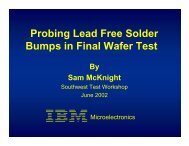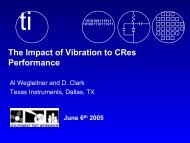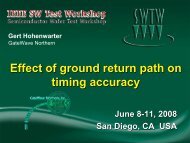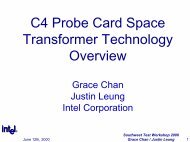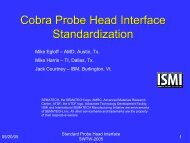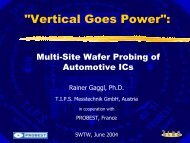Methodologies for Assessing On-line Probe Process Parameters
Methodologies for Assessing On-line Probe Process Parameters
Methodologies for Assessing On-line Probe Process Parameters
You also want an ePaper? Increase the reach of your titles
YUMPU automatically turns print PDFs into web optimized ePapers that Google loves.
Jan Martens<br />
NXP Semiconductors Germany<br />
Simon Allgaier<br />
Feinmetall GmbH<br />
Jerry Broz, Ph.D.<br />
International Test Solutions<br />
<strong>Methodologies</strong> <strong>for</strong> <strong>Assessing</strong> <strong>On</strong>-<strong>line</strong> <strong>On</strong> <strong>line</strong><br />
<strong>Probe</strong> <strong>Process</strong> <strong>Parameters</strong><br />
June 8-11, 8 11, 2008<br />
San Diego, CA USA
• Motivation<br />
Content<br />
• Joint Venture Overview<br />
– FM: <strong>Probe</strong> Materials<br />
– ITS: Lab Capabilities<br />
– NXP: Production Environment<br />
• Contact Resistance and Fritting Theory<br />
• Experimental Data<br />
• Production Data<br />
• Results & Future Work<br />
June 11 / 2008 Martens, Allgaier, Allgaier Allgaier, , Broz IEEE SW Test Workshop 2
Motivation<br />
Joint Venture Overview<br />
FM: <strong>Probe</strong> Materials<br />
ITS: Lab Capabilities<br />
NXP: Production Environment<br />
Contact Resistance and Fritting Theory<br />
Experimental Data<br />
Production Data<br />
Results & Future Work<br />
June 11 / 2008 Martens, Allgaier, Allgaier Allgaier, , Broz IEEE SW Test Workshop 3
Motivation<br />
• Production sort floors are often manpower, materials,<br />
and financially limited <strong>for</strong> fundamental characterization<br />
studies which could lead to process understanding and<br />
improvement.<br />
• Testing with “full-build” probe cards is expensive and<br />
often not feasible, particularly with large array probe<br />
cards.<br />
• <strong>Assessing</strong> combinations of key parameters, such as<br />
current amplitude and directionality, probe needle<br />
materials, and FAB processing effects on bond pads,<br />
requires substantial resource allocation.<br />
• Bench-top testing with a single probe or reduced probe<br />
count test vehicles can be per<strong>for</strong>med quickly under<br />
known and controlled conditions.<br />
June 11 / 2008 Martens, Allgaier, Allgaier Allgaier, , Broz IEEE SW Test Workshop 4
Motivation<br />
Joint Venture Overview<br />
FM: <strong>Probe</strong> Materials<br />
ITS: Lab Capabilities<br />
NXP: Production Environment<br />
Contact Resistance and Fritting Theory<br />
Experimental Data<br />
Production Data<br />
Results & Future Work<br />
June 11 / 2008 Martens, Allgaier, Allgaier Allgaier, , Broz IEEE SW Test Workshop 5
Feinmetall Vi<strong>Probe</strong> ®<br />
New Beam Material<br />
• Beam material with improved per<strong>for</strong>mance:<br />
- high amperage (current carrying capacity,<br />
up to 800 mA)<br />
- low voltage/current applications<br />
- electrical resistivity: 0.12 Ω . mm 2 /m<br />
• Both materials (existing and new one) are<br />
palladium - silver alloys<br />
• Mechanical behaviour of the new beams similar<br />
to the existing beams with 2.0 mil, 2.5 mil and<br />
3.0 mil diameter<br />
June 11 / 2008 Martens, Allgaier, Allgaier Allgaier, , Broz IEEE SW Test Workshop 6
Feinmetall Vi<strong>Probe</strong> ®<br />
New Beam Material<br />
• <strong>Probe</strong> Force vs. Applied Current<br />
<strong>Probe</strong> Force (grams)<br />
9.00<br />
8.00<br />
7.00<br />
6.00<br />
5.00<br />
4.00<br />
3.00<br />
2.00<br />
1.00<br />
0.00<br />
Current Carrying Capacity<br />
(3-mil Vi<strong>Probe</strong> Beams at 100-um OT)<br />
Existing Material<br />
CCC ~ 560 mA<br />
0 100 200 300 400 500 600 700 800 900 1000<br />
Applied Current (mA)<br />
Existing New Material<br />
New Exist Material<br />
New Material<br />
CCC ~ 780 mA<br />
20% Reduction<br />
~ 6.50 g<br />
June 11 / 2008 Martens, Allgaier, Allgaier Allgaier, , Broz IEEE SW Test Workshop 7
Vi<strong>Probe</strong> ® Testvehicle<br />
• Smallest Vi<strong>Probe</strong> ® test head ever designed and built<br />
– 2mil, 2.5mil and 3mil Vi<strong>Probe</strong> compatibility<br />
25-PIN D-Sub<br />
Connector<br />
<strong>Probe</strong> Head<br />
Electrical<br />
Connection<br />
Connector<br />
Beams<br />
June 11 / 2008 Martens, Allgaier, Allgaier Allgaier, , Broz IEEE SW Test Workshop 8
Controlled Test Conditions<br />
• Bench-top instrument <strong>for</strong> material characterization and probe<br />
per<strong>for</strong>mance testing.<br />
NI LabVIEW<br />
Motion Control<br />
Data Acquisition<br />
Precision Stages<br />
ITS LTU <strong>Probe</strong>-Gen System<br />
• Testing System Details<br />
– Variable z-speed and z-acceleration.<br />
– Low gram load cell measurements.<br />
– Synchronized load vs. overtravel<br />
vs. CRES data acquisition.<br />
– High resolution video imaging and<br />
still image capture.<br />
– Current <strong>for</strong>cing and measurement<br />
with Keithley 2400 source-meter.<br />
– Micro-stepping capable to maximize<br />
number of touchdowns.<br />
– Multi-zone cleaning functionalities.<br />
June 11 / 2008 Martens, Allgaier, Allgaier Allgaier, , Broz IEEE SW Test Workshop 9
High resolution imaging<br />
system <strong>for</strong> video acquisition<br />
Test Vehicle<br />
Vi<strong>Probe</strong> Test vehicle installed<br />
onto 50 gram load cell<br />
<strong>Probe</strong> / Material Interaction<br />
and Buckling Visualization<br />
June 11 / 2008 Martens, Allgaier, Allgaier Allgaier, , Broz IEEE SW Test Workshop 10
NXP Testcenter Hamburg<br />
Production Environment<br />
• Mass production and engineering site <strong>for</strong><br />
Automotive and Identification business,<br />
digital and mixed signal<br />
• Applications with high multisite factors and<br />
small pad pitch<br />
• Capability to collect contact resistance<br />
data within production environment<br />
June 11 / 2008 Martens, Allgaier, Allgaier Allgaier, , Broz IEEE SW Test Workshop 11
Motivation<br />
Joint Venture Overview<br />
FM: <strong>Probe</strong> Materials<br />
ITS: Lab Capabilities<br />
NXP: Production Environment<br />
Contact Resistance and<br />
Fritting Theory<br />
Experimental Data<br />
Production Data<br />
Results & Future Work<br />
June 11 / 2008 Martens, Allgaier, Allgaier Allgaier, , Broz IEEE SW Test Workshop 12
Contact Resistance (CRES)<br />
• Contact Resistance is a combination two main parameters<br />
– Localized physical mechanisms … metallic contact<br />
– Non-conductive contribution … film resistance<br />
• Model <strong>for</strong> CRES has two main factors<br />
C RES<br />
=<br />
• ρpad , ρprobe , σfilm = resistivity values<br />
• H = hardness of softer material<br />
METALLIC<br />
CONTACT<br />
• P = contact pressure<br />
( ρ + ρ )<br />
probe<br />
4<br />
πH<br />
P<br />
– Contact pressure (P) applied <strong>for</strong>ce normalized by true contact area<br />
• Unstable CRES is dominated by the film contribution term<br />
due to the accumulation of non-conductive materials<br />
pad<br />
σ<br />
+<br />
June 11 / 2008 Martens, Allgaier, Allgaier Allgaier, , Broz IEEE SW Test Workshop 14<br />
film<br />
P<br />
H<br />
FILM<br />
RESISTANCE
Key Factors that affect CRES<br />
• Presence of contamination, e.g. debris, oxides, residues, etc.<br />
– Film resistance eventually dominates the magnitude and stability of<br />
the CRES<br />
• <strong>Probe</strong> tip shape plays an important role in displacing the<br />
contaminants from the true contact area<br />
– True Contact Area = F (Tip Shape, Applied Force, Surface Finish)<br />
• True contact are is “large” applied pressure and a-Spot density are “low”<br />
• True contact area is “small” applied pressure and a-Spot density are “large”<br />
• <strong>Probe</strong> tip surface characteristics affect the “a-Spot” density<br />
– Asperity density depends on the microscopic surface roughness<br />
• Smooth surfaces have a high asperity density<br />
• The increase in asperity density decreases the electrical CRES<br />
• A “rough” finish facilitates material accumulation on contact surface<br />
• Amplitude and directionality of the voltage or current applied.<br />
– Voltage or current must be sufficient to breakdown the oxide.<br />
June 11 / 2008 Martens, Allgaier, Allgaier Allgaier, , Broz IEEE SW Test Workshop 15
Fritting – Theory<br />
• The vertical <strong>Probe</strong> tip<br />
touches the contact pad.<br />
• Depending on the contact<br />
pressure the oxide film is<br />
broken partly and<br />
electrical bridges arise.<br />
• The number and size of<br />
the bridges is equivalent<br />
to the CRES quality<br />
<strong>Probe</strong> Tip<br />
Contact Pad<br />
June 11 / 2008 Martens, Allgaier, Allgaier Allgaier, , Broz IEEE SW Test Workshop 16
<strong>Probe</strong> tip<br />
Oxide film<br />
Contact pad<br />
Fritting – Theory<br />
• What happens, if bridges<br />
are only few and small?<br />
Small bridge through oxide film.<br />
Be<strong>for</strong>e high current flow.<br />
June 11 / 2008 Martens, Allgaier, Allgaier Allgaier, , Broz IEEE SW Test Workshop 17
Fritting – Theory<br />
• Current must flow through small bridge.<br />
• Bridge and neighbourhood are heated up<br />
• Contact Pad material migrates to the bridge.<br />
<strong>Probe</strong> tip<br />
Oxide film<br />
Contact pad<br />
High current flow situation:<br />
Black Lines of current flow.<br />
White Lines of equipotential surface.<br />
June 11 / 2008 Martens, Allgaier, Allgaier Allgaier, , Broz IEEE SW Test Workshop 18
Fritting – Theory<br />
• Bridge is widened C RES decreased<br />
• Contact pad material migrated to the bridge and tip<br />
surface<br />
<strong>Probe</strong> tip<br />
Oxide film<br />
Contact pad<br />
Wide bridge through oxide film.<br />
After high current flow.<br />
Tip surface is contaminated.<br />
June 11 / 2008 Martens, Allgaier, Allgaier Allgaier, , Broz IEEE SW Test Workshop 19
<strong>Probe</strong> Tip<br />
Contact Pad<br />
Fritting – What‘s What that? that<br />
• Fritting is a kind of electrical breakdown at the<br />
contact surface between the probe tip and the<br />
contact pad of the IC.<br />
• It improves the electrical contact by building or<br />
stabilizing bridges through the oxide film, if the<br />
film was not mechanically broken completely.<br />
• After Fritting the probe tip is welded with the<br />
contact pad. After removing the contact<br />
residuals of the welding remain at the probe<br />
tip and will oxidize.<br />
June 11 / 2008 Martens, Allgaier, Allgaier Allgaier, , Broz IEEE SW Test Workshop 20
Motivation<br />
Joint Venture Overview<br />
FM: <strong>Probe</strong> Materials<br />
ITS: Lab Capabilities<br />
NXP: Production Environment<br />
Contact Resistance and Fritting Theory<br />
Experimental Data<br />
Production Data<br />
Results & Future Work<br />
June 11 / 2008 Martens, Allgaier, Allgaier Allgaier, , Broz IEEE SW Test Workshop 21
Experimental Data / <strong>Parameters</strong><br />
• Input <strong>Parameters</strong>:<br />
– Overtravel (OT, µm)<br />
– <strong>Probe</strong> Material<br />
– Contact Material (Rhodium, Rh, Aluminum 600nm, Al)<br />
– Electrical Conditions (Current and direction, mA)<br />
– Number of Touchdowns (TDs)<br />
• Output Measures:<br />
– Contact Resistance (Cres, Ohm)<br />
– Contact Force (CF, cN)<br />
– Visual Inspection (Video Camera System)<br />
– Scanning Electron Microscope (SEM)<br />
June 11 / 2008 Martens, Allgaier, Allgaier Allgaier, , Broz IEEE SW Test Workshop 22
What is a “Bathtub Bathtub” Curve ?<br />
• A symmetric “bathtub” curve at full overtravel is<br />
preferable.<br />
If fritting occurs, will be<br />
observed in this region<br />
Full<br />
Overtravel<br />
OT increase | OT decrease<br />
A shift is indicative of material<br />
Accumulation on contact area<br />
Intrinsic<br />
CRES<br />
June 11 / 2008 Martens, Allgaier, Allgaier Allgaier, , Broz IEEE SW Test Workshop 24
Bathtub Experiments<br />
• Test Sequence<br />
– CRES vs Overtravel per<strong>for</strong>mance tests up to 100µm<br />
overtravel (OT)<br />
– CRES measurement Pin-to-Pin with 3mil diameter<br />
• Test Execution <strong>for</strong> total 30 TDs each<br />
– Per<strong>for</strong>med on Rh-Plate and Al-Wafer<br />
– Per<strong>for</strong>med with existing and new beam material<br />
– Per<strong>for</strong>med at 1mA and 100mA<br />
June 11 / 2008 Martens, Allgaier, Allgaier Allgaier, , Broz IEEE SW Test Workshop 26
Contact Resistance Cres [Ohm]<br />
1000<br />
100<br />
10<br />
1<br />
Bathtub Comparison I<br />
600nm Al @ 1mA/exist. Mat<br />
Rhodium @ 1mA/exist. Mat<br />
Film<br />
Resistance<br />
Metallic<br />
Contact<br />
-5 5 15 25 35 45 55 65 75 85 95 105 95 85 75 65 55 45 35 25 15 5 -5<br />
OT [µm]<br />
June 11 / 2008 Martens, Allgaier, Allgaier Allgaier, , Broz IEEE SW Test Workshop 27
Contact Resistance Cres [Ohm]<br />
1000<br />
100<br />
Bathtub Comparison II<br />
10<br />
1<br />
Existing Mat @ 1mA/600nm Al<br />
New Mat @ 1mA/600nm Al<br />
Difference in CRES<br />
New Mat -550 mOhm<br />
-5 5 15 25 35 45 55 65 75 85 95 105 95 85 75 65 55 45 35 25 15 5 -5<br />
OT [µm]<br />
June 11 / 2008 Martens, Allgaier, Allgaier Allgaier, , Broz IEEE SW Test Workshop 28
Contact Resistance Cres [Ohm]<br />
Bathtub Comparison III<br />
1000<br />
100<br />
10<br />
1<br />
Fritting<br />
1mA @ 600nm Al/exist. Mat<br />
100mA @ 600nm Al/exist. Mat<br />
-5 5 15 25 35 45 55 65 75 85 95 105 95 85 75 65 55 45 35 25 15 5 -5<br />
OT [µm]<br />
June 11 / 2008 Martens, Allgaier, Allgaier Allgaier, , Broz IEEE SW Test Workshop 29
CRES vs. Current<br />
• Test Sequence<br />
– 30 TDs at 38µm Overtravel (no intermetallic contact<br />
on Al-Wafer)<br />
– CRES measurement Pin-to-Pin with 3mil beam<br />
diameter<br />
• Test Execution <strong>for</strong> total 30 TDs each<br />
– Per<strong>for</strong>med <strong>for</strong> a set of currents (1mA-1A)<br />
– Per<strong>for</strong>med on Rh-Plate and on Al-Wafer<br />
– Per<strong>for</strong>med with existing and new beam material<br />
June 11 / 2008 Martens, Allgaier, Allgaier Allgaier, , Broz IEEE SW Test Workshop 30
Contact Resistance Cres [Ohm]<br />
10<br />
8<br />
6<br />
4<br />
Difference in CRES<br />
New Mat 2 -550 mOhm<br />
0<br />
CRES vs. Current<br />
CRES decrease<br />
Because of Fritting<br />
0 100 200 300 400 500 600 700 800 900 1000<br />
Measurement Current [mA]<br />
Exist. Mat on Rhodium @ 38µm OT<br />
New Mat on Rhodium @ 38µm OT<br />
Exist. Mat on 600nm Al @38µm OT<br />
New Mat on 600nm Al @ 38µm OT<br />
June 11 / 2008 Martens, Allgaier, Allgaier Allgaier, , Broz IEEE SW Test Workshop 31
Visualization of Test<br />
• Pin-to-Pin CRES across substrates<br />
– NO FRITTING observed on Rhodium plate<br />
– FRITTING observed 600nm Aluminum wafer<br />
June 11 / 2008 Martens, Allgaier, Allgaier Allgaier, , Broz IEEE SW Test Workshop 32
CRES Longterm tests<br />
• Test Sequence<br />
– 200 TDs on a 600nm Aluminum Wafer at 38µm<br />
Overtravel<br />
– CRES vs Overtravel per<strong>for</strong>mance tests up to 100µm<br />
overtravel on a Rh-Plate<br />
• Test Execution <strong>for</strong> total of 20K TDs on wafer<br />
– Al-wafer with 1mA and Rh-Plate at 1mA<br />
– Al-wafer with 300mA and Rh-Plate at 300mA<br />
– Per<strong>for</strong>med with existing and new beam material<br />
– Per<strong>for</strong>med Pin-To-Pin<br />
– No Cleaning at all<br />
June 11 / 2008 Martens, Allgaier, Allgaier Allgaier, , Broz IEEE SW Test Workshop 33
Contact Resistance Cres [Ohm]<br />
10<br />
8<br />
6<br />
4<br />
2<br />
0<br />
CRES Longterm Tests<br />
-5<br />
5<br />
Fritting<br />
15<br />
25<br />
35<br />
45<br />
55<br />
65<br />
75<br />
Start of Longtermtest 1mA (Exist Mat)<br />
Start of Longtermtest 300mA (Exist Mat)<br />
End of Longtermtest 1mA (Exist Mat)<br />
End of Longtermtest 300mA (Exist Mat)<br />
More Cur. = More CRES<br />
(Film resistance)<br />
85<br />
95<br />
105<br />
95<br />
OT [µm]<br />
June 11 / 2008 Martens, Allgaier, Allgaier Allgaier, , Broz IEEE SW Test Workshop 34<br />
85<br />
75<br />
65<br />
55<br />
45<br />
35<br />
25<br />
15<br />
5<br />
-5
Contact Resistance Cres [Ohm]<br />
10<br />
8<br />
6<br />
4<br />
2<br />
0<br />
CRES Longterm Tests<br />
-5<br />
5<br />
Fritting<br />
Expected Offset<br />
Exist vs new Mat<br />
15<br />
25<br />
35<br />
45<br />
55<br />
65<br />
75<br />
Exist. Mat: Start of longtermtest @ 300mA<br />
New Mat: Start of longtermtest @ 300mA<br />
Exist. Mat: End of longtermtest @ 300mA<br />
New Mat: End of longtermtest @ 300mA<br />
85<br />
95<br />
105<br />
95<br />
OT [µm]<br />
June 11 / 2008 Martens, Allgaier, Allgaier Allgaier, , Broz IEEE SW Test Workshop 35<br />
85<br />
75<br />
65<br />
55<br />
45<br />
35<br />
25<br />
15<br />
5<br />
-5
SEM Images after 20K TD Longterm Test<br />
@ 1 and 300mA without any Cleaning<br />
Existing Material - Initial<br />
New Material - Initial<br />
20K 1mA Al + 1mA Rh<br />
20K 1mA Al + 1mA Rh<br />
20K 300mA Al + 300mA Rh<br />
20K 300mA Al + 300mA Rh<br />
June 11 / 2008 Martens, Allgaier, Allgaier Allgaier, , Broz IEEE SW Test Workshop 36
CRES Longterm Tests<br />
• Test Sequence<br />
Pin High / Low<br />
– 200 TDs on a 600nm Aluminum Wafer at 25µm<br />
Overtravel<br />
– CRES vs Overtravel per<strong>for</strong>mance tests up to 100µm<br />
overtravel on a Rh-Plate<br />
• Test Execution <strong>for</strong> total of 20K TDs on wafer<br />
– Pin with 300mA (High) and Rh-Plate (Low)<br />
– Pin with 300mA (Low) and Rh-Plate (High)<br />
– Per<strong>for</strong>med with existing and new probe material<br />
– Per<strong>for</strong>med without cleaning<br />
June 11 / 2008 Martens, Allgaier, Allgaier Allgaier, , Broz IEEE SW Test Workshop 37
CRES Longterm Tests<br />
CRES Histogram after 15K TDs @ 300mA without Cleaning<br />
Number of Contacts<br />
1400<br />
1200<br />
1000<br />
800<br />
600<br />
400<br />
200<br />
0<br />
Metallic<br />
Contact<br />
Exist Mat<br />
Metallic<br />
Contact<br />
New Mat<br />
Film<br />
Resistance<br />
New Mat<br />
Film<br />
Resistance<br />
Exist Mat<br />
0 1 2 3 4 5 6<br />
Contact Resistance [Ohm]<br />
Exist mat / Pin low<br />
Exist Mat / Pin high<br />
New Mat / Pin low<br />
New Mat / Pin high<br />
June 11 / 2008 Martens, Allgaier, Allgaier Allgaier, , Broz IEEE SW Test Workshop 38
CRES Longterm tests<br />
CRES Cum. Probability after 15K TDs @ 300mA without Cleaning<br />
Cumulative Probability<br />
100%<br />
80%<br />
60%<br />
40%<br />
20%<br />
0%<br />
Metallic<br />
Contact<br />
Exist Mat<br />
Metallic<br />
Contact<br />
New Mat<br />
90% Film Resistance<br />
90% Film Res.<br />
0 1 2 3 4 5 6<br />
Contact Resistance [Ohm]<br />
Less<br />
Film resistance<br />
<strong>for</strong> pos. Volt.<br />
at new Mat<br />
Exist mat / Pin low<br />
Exist Mat / Pin high<br />
New Mat / Pin low<br />
New Mat / Pin high<br />
June 11 / 2008 Martens, Allgaier, Allgaier Allgaier, , Broz IEEE SW Test Workshop 39
Exist<br />
Mat<br />
New<br />
Mat<br />
SEM Images after 20K TD Longterm Test<br />
@ 300mA without any Cleaning<br />
Pin low Pin High<br />
June 11 / 2008 Martens, Allgaier, Allgaier Allgaier, , Broz IEEE SW Test Workshop 40
Motivation<br />
Joint Venture Overview<br />
FM: <strong>Probe</strong> Materials<br />
ITS: Lab Capabilities<br />
NXP: Production Environment<br />
Contact Resistance and Fritting Theory<br />
Experimental Data<br />
Production Data<br />
Results & Future Work<br />
June 11 / 2008 Martens, Allgaier, Allgaier Allgaier, , Broz IEEE SW Test Workshop 41
Production CRES Measurement<br />
• Smartcard application 32x parallel<br />
• <strong>On</strong>e <strong>Probe</strong>card with<br />
16 sites existing Material (red)<br />
16 sites new Material (green)<br />
with symmetric pattern<br />
• CRES Monitor on digital channel<br />
put into std. Production Test<br />
Program<br />
1 2 3 4<br />
5 6 7 8<br />
9 10 11 12<br />
13 14 15 16<br />
17 18 19 20<br />
21 22 23 24<br />
25 26 27 28<br />
29 30 31 32<br />
June 11 / 2008 Martens, Allgaier, Allgaier Allgaier, , Broz IEEE SW Test Workshop 42
Number of Contacts<br />
1800<br />
1600<br />
1400<br />
1200<br />
1000<br />
800<br />
600<br />
400<br />
200<br />
0<br />
Production Data<br />
Exist Material<br />
New Material<br />
CRES Difference<br />
550 mOhm<br />
4 4.2 4.4 4.6 4.8 5 5.2 5.4<br />
Overall Path Resistance [Ohm]<br />
June 11 / 2008 Martens, Allgaier, Allgaier Allgaier, , Broz IEEE SW Test Workshop 43
Motivation<br />
Joint Venture Overview<br />
FM: <strong>Probe</strong> Materials<br />
ITS: Lab Capabilities<br />
NXP: Production Environment<br />
Contact Resistance and Fritting Theory<br />
Experimental Data<br />
Production Data<br />
Results & Future Work<br />
June 11 / 2008 Martens, Allgaier, Allgaier Allgaier, , Broz IEEE SW Test Workshop 44
Results & Future Work I<br />
• New beam material was evaluated in lab and production<br />
environments<br />
– Decrease of resistivity proven: -550 mOhm compared to existing<br />
material<br />
– New Beam material shows better film contact resistance and fritting<br />
per<strong>for</strong>mance<br />
• Amplitude and directionality of applied current/voltage highly<br />
influenced the accumulation of debris as well as the increase of film<br />
resistance<br />
– Higher currents lead to higher CRES<br />
– Positive voltages higher affected than negative voltages<br />
• Off-<strong>line</strong> testing under controlled conditions with “standardized”<br />
methods can provide key insights <strong>for</strong> understanding CRES behavior<br />
that can help a probe engineer develop wafer sort processes and<br />
define cleaning practices.<br />
June 11 / 2008 Martens, Allgaier, Allgaier Allgaier, , Broz IEEE SW Test Workshop 45
Results & Future Work II<br />
(many interestesting studies !)<br />
• Evaluate fab processed materials<br />
– Shorted wafers and test die<br />
• Define an “<strong>On</strong><strong>line</strong> Cleaning Rules Set”<br />
• Investigating the effects and repercussions<br />
of the Fritting mechanisms<br />
• Temperature influence on film resistance<br />
– Range similar to production<br />
June 11 / 2008 Martens, Allgaier, Allgaier Allgaier, , Broz IEEE SW Test Workshop 46
Acknowledgements<br />
• Feinmetall Engineering Development and<br />
Design Teams<br />
• ITS Applications Engineering Team<br />
– Andrea Haag (Engineering Technician)<br />
June 11 / 2008 Martens, Allgaier, Allgaier Allgaier, , Broz IEEE SW Test Workshop 47
Men At Work<br />
June 11 / 2008 Martens, Allgaier, Allgaier Allgaier, , Broz IEEE SW Test Workshop 48
Thank you! you<br />
Questions?<br />
Questions



